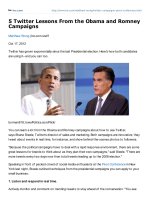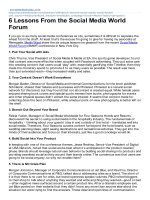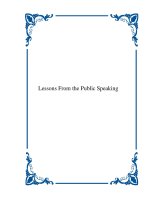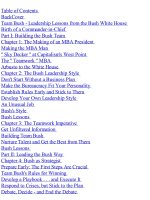Presentations in action~80 memorable presentation lessons from the masters 2011
Bạn đang xem bản rút gọn của tài liệu. Xem và tải ngay bản đầy đủ của tài liệu tại đây (1.19 MB, 147 trang )
Presentations in Action
80 Memorable Presentation Lessons from the Masters
Jerry Weissman
Vice President, Publisher: Tim Moore
Associate Publisher and Director of Marketing: Amy Neidlinger
Executive Editor: Jeanne Glasser
Editorial Assistant: Pamela Boland
Art Consultant: Nichole Nears
Development Editor: Russ Hall
Operations Manager: Gina Kanouse
Senior Marketing Manager: Julie Phifer
Publicity Manager: Laura Czaja
Assistant Marketing Manager: Megan Colvin
Cover Designer: Alan Clements
Managing Editor: Kristy Hart
Senior Project Editor: Lori Lyons
Copy Editor: Krista Hansing Editorial Services, Inc.
Proofreader: Chrissy White, Language Logistics, LLC
Senior Indexer: Cheryl Lenser
Senior Compositor: Gloria Schurick
Manufacturing Buyer: Dan Uhrig
© 2011 by Power Presentations
Pearson Education, Inc.
Publishing as FT Press
Upper Saddle River, New Jersey 07458
FT Press offers excellent discounts on this book when ordered in quantity for bulk purchases or
special sales. For more information, please contact U.S. Corporate and Government Sales, 1-800382-3419, For sales outside the U.S., please contact International
Sales at
Company and product names mentioned herein are the trademarks or registered trademarks of their
respective owners.
All rights reserved. No part of this book may be reproduced, in any form or by any means, without
permission in writing from the publisher.
Printed in the United States of America
First Printing May 2011
Pearson Education LTD.
Pearson Education Australia PTY, Limited.
Pearson Education Singapore, Pte. Ltd.
Pearson Education Asia, Ltd.
Pearson Education Canada, Ltd.
Pearson Educación de Mexico, S.A. de C.V.
Pearson Education—Japan
Pearson Education Malaysia, Pte. Ltd.
Library of Congress Cataloging-in-Publication Data
Weissman, Jerry.
Presentations in action : 80 memorable presentation lessons from the masters / Jerry
Weissman.
p. cm.
Includes bibliographical references.
ISBN 978-0-13-248962-1 (hardback : alk. paper) 1. Business presentations. I. Title.
HF5718.22.W4495 2011
658.4’52—dc22
2010050905
ISBN-10: 0-13-248962-7
ISBN-13: 978-0-13-248962-1
Contents
Introduction
Section I: Content: The Art of Telling Your Story
1. A Lesson from Professor Marvel, a.k.a. The Wizard of Oz: How to Customize Your
Presentation
2. Obama and You: The Most Persuasive Word
3. The “So What?” Syndrome: ... and How to Avoid It
4. Beware of Jokes: Dispelling a Common False Belief
5. Presentation Advice from Abraham Lincoln: Clarity, Ownership, and Add Value
6. It Ain’t What You Say, It’s How You Say It: Lessons in Structure from Jeffrey Toobin
and Andrew Weil, M.D.
7. Presentation Advice from Mark Twain: Brevity Takes Time
8. Presentation Advice from Mike Nichols: How to Find Value in Your Story
9. Show versus Tell in Hollywood: The Wrong and the Right Way to Tell a Story
10. Slogan Power: Why the U.S. Army’s “Be All That You Can Be” Succeeded
11. How Long Is Too Long?: When in Doubt, Leave it Out
12. The Elevator Pitch in One Sentence: How to Describe Your Business Succinctly
13. Do You Know the Way to Spanish Bay?: The Correct Way to Practice
14. Getting to “Aha!”: The Magic Moment
15. This Is Your Pilot Speaking: A Lesson in Flow from the Airlines
16. Presentation Advice from the iPhone: Substance and Style in Your Story
17. Presentation Advice from Steve Jobs: The Power of Positive Words
18. Presentation Advice from Novelists I: Begin with the End in Mind, Then Write, Rewrite,
and Rewrite
19. Presentation Advice from Novelists II: Storyboard and Verbalize
20. Microsoft Slogans Score a Trifecta: Three Persuasive Techniques
21. Presentation Advice from a Physician: Audience Advocacy
22. Presentation Advice from a Politician: Audience Advocacy
23. Ronald Reagan Meets Lenny Skutnik: The Catalyst of Human Interest Stories
24. Human Interest Stories: A Double Advantage: Two Ways to Use Anecdotes
Section II: Graphics: The Correct Way to Design PowerPoint Slides
25. The Presentation-as-Document Syndrome: Never the Twain Shall Meet
26. Blame the Penmanship, Not the Pen: Operator versus Machine Error
27. You Can’t Use a Sentence As a Prompt!: Less Verbiage Is More Useful
28. Baiting the Salesperson: Selling Is about In-Person Communication
29. PowerPoint and Human Perception: Scientific Support for Graphics Design
30. PowerPoint Template: Combined Picture and Text: The Best Positions for Pictures and
Text
31. Shady Characters: The Wrong Way and the Right Way to Build Text
32. “I Can Read It Myself!”: Three Simple Steps to Avoid Reading Slides Verbatim
33. A Case for Case I: Initial Caps or All Caps: Text Design in Presentations
34. A Case for Case II: Serif or Sans: Font Design in Presentations
35. What Color Is Your PowerPoint?: Contrast Counts
36. Presentation Advice from Corona Beer: Peripheral Vision Counts
37. The Cable Crawlers: How Television Animates Text
38. Computer Animation: Three Simple Rules
39. PowerPoint and the Military: Sometimes More Is More
Section III: Delivery Skills: Actions Speak Louder Than Words
40. The Art of Conversation: Eye Contact and Interaction Start at Infancy
41. Presentation Advice from Edward R. Murrow: The “Person-to-Person” Role Model
42. Nonverbal Communication: Look Them in the Eye
43. Presentation Advice from Pianist Murray Perahia: Concentration Creates Control
44. Presentation Advice from Actress Tovah Feldshuh: Concentration Creates
Communication
45. Presentation Advice from Michael Phelps and Dara Torres: How to Control Stress under
Pressure
46. Presentation Advice from Frank Sinatra: The Art of Phrasing
47. Presentation Advice from Soprano Kiri Te Kanawa: The Importance of Breathing
48. The One-Eyed Man: Necessity Is the Mother of Invention
49. Bill Clinton’s Talking to Me!: The Power of Group Dynamics
50. Liddy Dole and Person-to-Person: From Law School to the Republican National
Convention
51. Fast Talking: Fun or Maddening
52. Presentation Advice from Titian: Position, Position, Position
53. Presentation Advice from Musicians and Athletes: The Value of Effortlessness
54. Presentation Advice from Vin Scully: From Reagan to Barber to Scully
55. “Ya’ Either Got It or Ya’ Ain’t”: The Fear of Public Speaking Is Universal
56. How to Eliminate the Fig Leaf: A Presentation Lesson from the Military
57. Unwords: Even Barack Obama Says Them
58. To Slip or Not to Slip: Been There, Done That
59. The Free Throw: A Presentation Lesson from Basketball
60. 10 Tips for 30 Seconds: Help for Job Seekers
61. You Are What You Eat: Ten Tips about Food and Drink in Presentations
Section IV: Q&A: Handling Tough Questions
62. Speed Kills in Q&A: The Vanishing Art of Listening
63. A Lesson in Listening from Barack Obama: How to Handle Multiple Questions
64. If I Could Tell Jon Stewart...: Talk Shows Include Listening
65. What Keeps You Up at Night?: How to Handle the Most Frequently Asked Questions
66. Spin versus Topspin: The Political World versus the Business World
67. When Did You Stop Beating Your Wife?: How to Handle False Assumption Questions
68. Madoff and Cramer Plead Guilty: How to Respond When Guilty as Charged
69. Tell Me the Time, Not How to Build a Clock: Keep Your Answers Short
70. Presentation Advice from Jerry Rice: Grasp the Question before You Answer
71. Politicians and Spin: Putting Lipstick on a Pig
72. Murder Boards: How Elena Kagan Prepared for Tough Questions
73. Ms. Kagan Regrets: Nonanswers to Tough Questions
Section V: Integration: Putting It All Together
74. The Elephant: The Whole Is Greater Than the Sum of the Parts
75. Presentation Graphics Meet Linguistics: Symmetry in Graphics Design
76. One Presentation, Multiple Audiences: 12 Presenters, 12 Stories, 1 Set of Slides
77. The Art and Science of Oprah Winfrey: The Secrets of Oprah Winfrey’s Appeal
78. Right or Left: The Deep Roots of Human Preferences
79. Graphics Synchronization: The Missing Link
80. The House That Jack Built: Make All the Parts Fit
Footnotes
Acknowledgments
About the Author
Financial Times Press
Index
Dedication
For my Lovely Lady Lucie again . . . and again
Praise for Presentations in Action
“Jerry Weissman is the Jedi Master of presentations and effective communication. Presentations in
Action is a wonderful compilation of 80 interesting examples and stories that will make you think and
help you improve your presentations and public speaking. I’ve added this important and to-the-point
book to my Jerry Weissman collection. Another fabulous read from the Silicon Valley legend.”
—Garr Reynolds, author of Presentation Zen and The Naked Presenter
“Across all fields there is one common trait of leaders: the ability to persuade groups to follow. This
is the field guide to persuasion, thus the field guide to successful leadership.”
—Scott Cook, Co-Founder and Chairman of the Executive Committee, Intuit, Inc.
“The best way to learn how to become great is to study the greatest. In Presentations in Action, the
world’s #1 presentations consultant presents 80 succinct lessons explaining what made the masters
effective. These simple lessons make it easier to be much better. Jerry taught me how to capture my
audience’s attention in the first minute of my talks with just six words, ‘Tell a story, not a joke.’ What
a difference.”
—Bill Davidow, Venture Capitalist, author of Marketing High Technology and Overconnected
“Jerry gives you 80 secrets from the world’s best persuaders, compacted into bite-sized chapters that
make them easy to read and easy to apply. Taken together they define the dynamics of communication
that can and have changed the world.”
—Peter Guber, Chairman of Mandalay Entertainment
“There’s nothing I love more than case studies and great presentations. Jerry’s book provides case
studies so you can make great presentations. It doesn’t get more enchanting than this.”
—Guy Kawasaki, author of Enchantment: The Art of Changing Hearts, Minds, and Actions
“Loved the book; it is the key to ‘message received’ because what is said is less important than what
is heard!”
—Vinod Khosla, Partner, Khosla Ventures
“Eighty Presentations Ideas from the Masters is like listening to football advice from Vince
Lombardi—elegant, purposeful, and direct. In this compact but complete book, Jerry Weissman gives
you all the right slants on public speaking and presentations. My favorite is Chapter 46, advice from
Frank Sinatra—who puts lyrics ahead of melody. Congratulations, Jerry, on an insightful
masterwork.”
—C. Richard Kramlich, Chairman, New Enterprise Associates
“Jerry’s coaching has been invaluable for many of our c-suite clients as they prepare for their debut
or return to the public markets. His high-impact presentation approach has been tremendously
successful. In addition, Jerry’s book series that detail his differentiating concepts have been
incredibly instructive.”
—Michael Millman, Managing Director, J.P. Morgan–Equity Capital Markets
Introduction
I hear and I forget.
I see and I remember.
I do and I understand.
Confucius (551 B.C.–479 B.C.)
In the more than two decades I have been a presentations coach, many people have heard me tell them
how to present effectively. They have also seen me show them, but the best results have come when I
coached my clients to do—to put the techniques into action.
It worked. Those clients’ presentations have raised hundreds of billions of dollars in public, private,
and even not-for-profit financing; sold hundreds of thousands of products; formed thousands of
partnerships; and gained approval for hundreds of internal projects.
Confucius was right about doing.
The techniques grew out of a variety of sources, going all the way back to my Master’s studies in the
Department of Speech and Drama at Stanford University and forward to my days as producer of
public affairs programs at WCBS-TV in New York City. Although I didn’t realize it at first, many of
the techniques that go into producing a television program are the same as those required to create
and deliver a winning presentation: telling a clear and concise story, designing effective graphics,
presenting with confidence, and handling tough questions (the latter developed from my CBS
assignment at the opposite end of the spectrum of preparing tough questions for the company’s
legendary inquisitor, Mike Wallace).
In 1988, I brought the accumulated techniques into the business world, where, after refining and
applying them as a coach in the private Power Presentations programs, I made them available to the
public in three books: Presenting to Win: The Art of Telling Your Story, The Power Presenter:
Technique Style and Strategy, and In the Line of Fire: How to Handle Tough Questions. Taken
together, the three books span all the essential elements of any presentation.
An important adjunct to the techniques was to illustrate them with examples of other presentations as
lessons of what to do and what not to do. Most of those examples came from my work with prior
clients and with public figures. As the years progressed, I accumulated a substantial repertory of case
studies from the business world and video clips from the political world. During that same time, I
found additional examples in such diverse fields as current events, politics, science, art, music,
literature, cinema, media, sports, and even the military. These variations from pure business cases
proved to be even more valuable as coaching tools and lessons because they demonstrated the
universal aspects of all human communication; in doing so they added significant dimension to the
basic techniques.
This book consists of 80 new case studies from the front of the room. They are grouped into five
sections mapped to the three original books, where you can find the basic techniques in full:
Section I—Content: The Art of Telling Your Story
Section II—Graphics: The Correct Way to Design PowerPoint Slides
Section III—Delivery Skills: Actions Speak Louder than Words
Section IV—Q&A: How to Handle Tough Questions
Section V—Integration: Putting It All Together
The first two sections relate to Presenting to Win, the third section, The Power Presenter, the fourth,
In the Line of Fire, and the fifth incorporates all three books. I am confident that these diverse case
studies will give you added depth and dimension for your presentation skills, as well as for all your
communication skills. But for the techniques to work most effectively, you must also follow the
advice of Confucius—and Nike—and just do it.
Section I. Content: The Art of Telling Your
Story
1. A Lesson from Professor Marvel, a.k.a. The Wizard of Oz: How
to Customize Your Presentation
In the opening scenes of The Wizard of OzF1.1, Dorothy runs away from her Kansas home and
promptly encounters Professor Marvel, a seedy, itinerant con artist whose tacky traveling wagon
advertises him as “Acclaimed by The Crown Heads of Europe.” He offers his services to “Read
Your Past, Present, and Future in His Crystal Ball.”
Professor Marvel, played marvelously by Frank Morgan, takes one look at the naive girl, glances
down at her suitcase, and says, “You’re running away!”
Having missed his glance, Dorothy asks wondrously, “How did you guess?”
The Professor replies, “Now, why are you running away? No, no, don’t tell me!” He looks off
pensively, as if conjuring some magical power. Then, as if having divined a vision, he says
conclusively, “They don’t understand you at home!”
The wide-eyed girl smiles and says, “Why, it’s just like you could read what was inside me!”
The Professor then offers Dorothy a crystal ball reading and asks her to close her eyes and
concentrate. As she does, the Professor quickly rummages around in her basket. He then proceeds to
describe what he pretends to see in the crystal ball, referencing the items in the basket.
Clearly, Professor Marvel is a charlatan, but we can learn a positive lesson from his trickery. He was
able to connect with Dorothy and establish her trust by referencing relevant facts about her. The
lesson here is that presenters can connect with their audiences by making references to relevant facts
about individuals in the audience or about the audience as an affinity group.
Such connections are rare in today’s presentations. Pressed by the demands of business, most
presenters pirate their colleagues’ slides, do minimal preparation, and then dump a load of generic
data on their audiences, who, to all intents and purposes, would have been better off accessing a
canned webinar.
Finding relevant facts that can customize any presentation doesn’t require manipulative glances, the
covert services of a private investigator, or an army of academic researchers. You can use seven
simple techniques to build powerful connections with any audience.
1. Direct References. Schmooze. Just before your presentation, mingle with your audience. Chat
with several different individuals. Talk with strangers and people you know. Ask them
questions. Listen to their conversations. Gather information, names, and data points. Then when
you step up to the front of the room, weave the names and information you’ve collected into your
presentation.
2. Mutual References. Before your presentation, learn as much as you can about your audience.
Visit their home pages. Cross-reference with a web search. Find links to persons, companies, or
organizations that are in some way related to both you and your audience. Then at appropriate
moments during your presentation, speak about those connections. Think of this as a tasteful,
appropriate form of name-dropping.
3. Ask Questions. During your presentation, ask your audience questions; seek their opinions
instead of answers to factual or true/false questions. Invite them to share their ideas, reactions,
4.
5.
6.
7.
or stories.
Contemporize. On the day of your presentation, scour the Web, read the newspapers, listen to
the radio, or watch television and find events or items that are relevant to your subject and your
audience.
Localize. Prepare specific references to the venue of your presentation. Some information about
a locale is common knowledge; some is available on the Web. In addition, you can go to the web
site www.newseum.org/todaysfrontpages/flash/F1.2, where you can access that day’s front pages
of local daily newspapers around the country and around the world by city. Make your
presentations fresh with up-to-the-minute references.
Data. Find specific information that links to and supports your message. The more closely linked
your data is to your audience, the better. If the information you cite is new to your audience, they
will be impressed by the depth and currency of your knowledge. If your audience is already
aware of the data, they will be pleased that you made the effort to relate to them.
Customized First Slide. Begin your presentation with a slide that includes the location, date,
and logo of your audience or event.
You don’t have to pose as a Professor Marvel, but you can make your audience marvel at your efforts
to connect and personalize.
2. Obama and You: The Most Persuasive Word
In 2006, Time magazine picked “You” as the Person of the Year and published that issue with a
Mylar patch on the cover that served as a mirror for readers to see themselves.F2.1 The main theme of
that issue was the personal power enabled by the World Wide Web, but it also drew attention to the
power of the word you. If you search the Internet, you’ll find tens of thousands of references to a Yale
University study (unsubstantiated by Yale) ranking the 12 most persuasive words in the English
language. You leads the list. (The others, in descending order, are Easy, Money, Save, Love, New,
Discovery, Results, Proven, and Guarantee.)F2.2 Unsubstantiated or not, President Barack Obama, an
excellent speaker by any standard, fully understands and leverages the power of you.
Early in his campaign for the presidency, the New Yorker magazine ran a story about his campaign
strategy:
Obama now tries to make a more personal connection with voters. In the past, he has been
accused of making his campaign more about himself than about those who come to his
rallies. Now the word you is mentioned as much as the word I. “You’re not heard. They’re
not listening to what you need,” he told a crowd assembled at a rodeo site in Fort Madison
on a recent evening. “You deserve a president who is thinking about you.”F2.3
During his campaign, Mr. Obama’s web site displayed a headline banner that read, “I’m asking you to
believe. Not just in my ability to bring about real change in Washington ... I’m asking you to believe
in yours.”
Following his victory, Mr. Obama delivered his inaugural address, in which he used you or your 15
times, addressing the you of his audience, the “Americans of every race and region and station.” He
also used us, our, and we, pronouns that involve you. His speech included 23 instances of us, 62
instances of we, and a whopping 70 instances of our, which, when combined with the 15 instances of
you, represent more than 7 percent of the total 2,388 words in his speech.F2.4
Although the historic day was his to celebrate, Mr. Obama kept his audience in mind. Flash-forward a
year into his presidency. In a prime-time address to the nation from the United States Military
Academy at West Point, Mr. Obama committed 30,000 more troops to fight the war in Afghanistan.
The serious speech marked a significant change in his rhetorical style—from an audience-focused to a
self-focused point of view. He used you only ten times, with four of them in the closing, “Thank you.
God bless you. May God bless the United States of America. Thank you very much. Thank you.” That
left only six instances of the powerful word in the body of the speech. In sharp contrast, he used I 41
times.
The shift prompted Peggy Noonan, a Wall Street Journal political columnist—and former republican
presidential speechwriter—to exclaim, “I, I—ay yi yi. This is a man badly in need of an I-ectomy.”
She went on to explain:
George H.W. Bush famously took the word “I” out of his speeches—we called them “Iectomies”—because of a horror of appearing to be calling attention to himself. Mr. Obama
is plagued with no such fears. “When I took office ... I approved a long-standing request ....
After consultations with our allies, ... I set a goal.” That’s all from one paragraph. He then
used the word I in three paragraphs an impressive 15 times. “I believe I know,” “I have
signed,” “I have read,” “I have visited.”F2.5
Granted, any senior executive—from the President of the United States to a midlevel manager in
business—must take full responsibility for all decisions and actions, but Mr. Obama should not
abandon the technique that helped get him elected.
The lesson for you is to involve your audiences by finding as many opportunities as you can to
incorporate you in your presentations. In fact, adding you enhances any form of communication, from
the soaring rhetoric of presidential addresses to the mundane routine of email. Try this simple
practice: Before clicking Send on any message, make one final review to see where you can insert
additional instances of you. Every time you do, you will heighten the impact of your message. Do the
same throughout your presentations, and you will connect more often with your audiences and
heighten your chances for success.
It is all about you, not hubris.
3. The “So What?” Syndrome: ... and How to Avoid It
How often have you sat in an audience listening to a presentation and said to yourself, “So what?”
If you are like most audience members—or like me, a presentations coach—your response to that
question would likely range from “Quite often” to “Too often.” Most presentations fail to address the
audience’s point of view. Worse still, most presentations, being all about the presenter, fail to offer
benefits. Either failure produces the dreaded “So what?” Syndrome that produces disinterest and,
ultimately, disconnect in the audience.
As a coach, I help my clients avoid failure by using “So what?” to a positive end. In coaching
sessions with clients, I role-play an audience member: a potential customer for a product, a potential
investor for a private or public financing, a manager for a project approval, a partner for a strategic
alliance, or even a donor for a not-for-profit cause. In one session with a pharmaceutical company
preparing for its Initial Public Offering (IPO), as the CEO rehearsed his road show, I assumed the
role of an institutional investor. When the CEO described the clinical trials for his drug, he concluded
his discussion by saying, “These trials prove that our drug is both safe and efficacious.”
I stopped him and said, “So what?”
The CEO thought for a moment, and then added, “which will make our drug the preferred choice for
physicians and generate significant revenues for our company.” “Safe and efficacious” were valuable
benefits for a physician who could prescribe the drug, but “generate significant revenues” is a benefit
for an investor.
One of the most effective ways to avoid the “So what?” Syndrome in your presentation is to insert a
WIIFY. WIIFY is an acronym of “What’s in it for you?” and is based on the common axiom, “What’s
in it for me?” The shift of the last word from me to you is deliberate because it shifts the focus from
the presenter to the audience. The shift also leverages the power of you, the persuasive word you
read about in the previous chapter. Think of the WIIFY as the ultimate benefit statement.
To insert a WIIFY in your presentation, pause your forward progress at a key point and start this
sentence: “This is important to you because ....” Then finish it with a benefit to your target audience.
Or pause at another key point and pose this rhetorical question: “What does this mean to you?” Then
answer it with a benefit to your target audience, a WIIFY.
Or pause at another key point and pose this rhetorical question: “Why am I telling you this?” Then
answer it with a WIIFY.
Find as many key points as you can to insert WIIFYs in every presentation you give, and you will see
the “So what?” interruptions vanish.
That last sentence is a WIIFY for you.
4. Beware of Jokes: Dispelling a Common False Belief
One of the most pervasive pieces of advice bandied about in the presentation trade is to start a speech
or a presentation with a joke. Wrong! No one can guarantee the success or failure of any joke—
certainly not a businessperson, but not even a professional comedian.
Consider Johnny Carson. The legendary talk-show host spent 30 years on late-night television telling
jokes written by a crack team of professional, experienced comedy writers, but the jokes didn’t
always work. Fortunately, one of Johnny’s greatest assets was his ability to recover from failed
jokes. Whenever a scripted gag elicited no reaction or even groans from his audience, Mr. Carson
mugged a silent take or made a comment about the bomb; either response often produced more
laughter than some of the scripted jokes.
Consider one of Mr. Carson’s most prominent successors, Jon Stewart of “The Daily Show.”
Although Mr. Stewart’s adulatory studio audiences worship and roar at almost every word he utters,
he occasionally produces a dud. Mr. Stewart recovers with one his many rubber-faced expressions or
trademark cackles which, as with Mr. Carson, often produces more laughter than the planned gags.
If Johnny Carson and Jon Stewart can’t guarantee a laugh, how can you?
Still, the temptation persists to break the ice in presentations with humor, to lighten up the
proceedings, entertain, or engage the audience; all are noble intentions but still risky business. Even if
a joke beats the odds and gets a laugh, the laughter is a digression from the main message of the
speech or presentation.
The risk of humor is even riskier in today’s globalized world and its diverse audiences. But diverse
cultures still retain their original sensibilities, and comedy does not cross borders easily—even with
a common language. U.S. humor and U.K. humour differ by much more than a single letter. If you have
any doubt, watch Americans in the audience of a British music hall comedy. They are the only ones
not laughing.
If, despite all these caveats, you still insist on telling a joke in your speech or presentation, make it
self-deprecating. If you fail at making fun of yourself, your failure will be at your expense and not at
your audience’s.
5. Presentation Advice from Abraham Lincoln: Clarity, Ownership,
and Add Value
Ted Sorensen, who was John F. Kennedy’s special counsel and speechwriter, most notably for his
historic inaugural address, studied the texts of Abraham Lincoln’s speeches—at JFK’s request—for
style ideas. In an article for the Smithsonian magazine, Sorensen wrote that JFK “also asked me to
read all previous twentieth-century inaugural addresses. I did not learn much from those speeches
(except for FDR’s first inaugural), but I learned a great deal from Lincoln’s ten sentences.”F5.1
The ten sentences Mr. Sorenson referenced are those of the memorable Gettysburg Address, but he
also analyzed Mr. Lincoln’s first inaugural address and, in particular, its last line. When Mr. Lincoln
delivered the speech on March 4, 1861, the secession by Southern states was threatening to plunge the
nation into Civil War. In his desire to conclude his oration on a note of unanimity, Lincoln carefully
considered his wording.
“He needed no White House speechwriter,” Mr. Sorensen said. “He wrote his major speeches out by
hand, as he did his eloquent letters and other documents. Sometimes he read his draft speeches aloud
to others, including members of his cabinet.” In the case of the first inaugural address, Lincoln shared
a draft with Secretary of State William Seward, who offered this suggestion for the closing sentence:
The mystic chords, which, proceeding from so many battlefields and so many patriot graves,
pass through all the hearts and all the hearths in this broad continent of ours, will yet
harmonize in their ancient music when breathed upon by the guardian angels of the nation.
Mr. Sorensen added that “Lincoln graciously took and read Seward’s suggested ending, but, with the
magic of his own pen, turned it into his moving appeal:”
The mystic chords of memory, stretching from every battlefield and patriot grave to every
living heart and hearthstone all over this broad land, will yet swell the chorus of the Union,
when again touched, as surely they will be, by the better angels of our nature.
Presenters can learn a triple lesson:
1. Clarity. Mr. Seward’s version of the sentence rambled on in a long, convoluted series of
subordinate clauses. In Mr. Lincoln’s rewrite, each clause builds upon the other in a straight
ascending arc to culminate on a strong, affirmative note. The lesson for you is not about poetic or
lyrical progression, but about succinctness. All too often, presenters ramble on in long
convoluted sentences that wend their way into the weeds. Speak in crisp, clear, and brief
phrases. Make your points and move on.
2. Ownership. Presenters must take responsibility for their own presentations. You cannot and
must not attempt to deliver someone else’s presentation, nor can you delegate the creation of
your presentation to another person or group. This does not mean that you should write out every
word by hand, as Mr. Lincoln did, but do participate in the development of the content.
However, you must practice your presentation as Mr. Lincoln did. Speak it aloud—to others or
to yourself—several times in advance, because only then will you feel comfortable and be
effective when you deliver it.
I realize that this recommendation presents a challenge in the corporate world, where, in the
interest of unified messaging, presentations are usually generated by a central marketing group
and then distributed throughout the organization. This not to say that you should depart from the
company story, but to take that story, tweak it to your style and practice it aloud.
3. Add Value. Mr. Sorensen researched diligently on behalf of JFK, and so did Mr. Lincoln on his
own behalf. Mr. Sorensen noted that Mr. Lincoln had a “willingness to dig out facts (as his own
researcher).” No one knows your own subject as well as you do, but don’t rely only on your
knowledge alone; find additional supporting information to add value to your story.
If Abraham Lincoln could do all this and run the country, you can find the time to take charge of your
presentation.
6. It Ain’t What You Say, It’s How You Say It: Lessons in Structure
from Jeffrey Toobin and Andrew Weil, M.D.
The first commandment in all communications is that the messenger is just as important as the
message—or, in the vernacular, it ain’t what you say, it’s how you say it.
Jeffrey Toobin and Andrew Weil, M.D., are, by any standard, on the A-list of public speakers. Each
man has what is known on the keynote speaking circuit as a solid platform. The term refers to a large
installed base of loyal followers built by frequent access to and exposure in the media. Mr. Toobin, a
legal political analyst for CNN, appears regularly on that cable channel; and Dr. Weil, a trusted
health advisor (as his trademark reads), runs a vast online marketplace that sells personal care
products, vitamins, and cookware. Each man also has a string of bestselling books, including Mr.
Toobin’s The Nine and Dr. Weil’s Natural Health, Natural Medicine. All these factors create an
attractive draw for their public speaking engagements.
As part of the San Francisco Bay Area’s lecture series, both men drew sold-out crowds of more than
3,000 people to the historic Frank Lloyd Wright–designed Marin Civic Center. Both men are dynamic
speakers, but their individual styles present an interesting study in contrasts.
Of the two, Mr. Toobin was more effective, despite that fact that Dr. Weil’s subject—health—was of
greater intrinsic and personal value to the audience than Mr. Toobin’s drier subject—the Supreme
Court. The difference was their organizational structures.
During his hour, Dr. Weil touched on a wide array of subjects, including vitamins, diet, health care
reimbursement, and even an audience-participation breathing exercise that had all 3,000 people
huffing and puffing along with him. Although Dr. Weil covered each topic thoroughly, each one stood
alone, without a link or transition to the next, making it challenging to follow. Mr. Toobin, on the
other hand, had a single theme: the composition of the Supreme Court. Although he moved backward
and forward in time, discussing the varying combinations of the nine justices in different decades, and
although he peppered each story with human interest anecdotes, his speech was easy to follow
because each move and anecdote supported and pivoted around the central theme. Mr. Toobin held
the audience in rapt attention throughout his speech.
What made Mr. Toobin’s structure work? How could Dr. Weil have improved his?
Speakers can select one of 16 different Flow Structures, or logical templates, to organize the diverse
components of any story into a clear roadmap for audiences. Presenting to Win describes all 16 in
detail, but 2 of the simplest and most frequently used are the Numerical and Chronological Flow
Structures. David Letterman uses the Numerical Flow Structure in his nightly “Top Ten,” and Stephen
Covey uses it in his Seven Habits of Highly Effective People. The Chronological Flow Structure is
often used in business to describe a company’s track record, present position, and future direction, or
to trace a product evolution from inception to release, to upgrade.
Jeffrey Toobin chose Numerical as his primary Flow Structure with Chronological as his secondary.
His central theme was the composition of the nine justices along liberal and conservative lines. The
shifting balance of power among the nine is a constant source of dramatic tension that drives
presidential elections, political parties, and many impassioned contending constituencies. Mr. Toobin
discussed the various majorities and minorities among the justices at different points in time. Because
of his central focus on the total number, he was able to jump backward and forward among different
decades and even add sidebar human interest stories, yet still maintain a clear narrative thread.
Dr. Weil could have created continuity by emulating David Letterman and Jeffrey Toobin by choosing
Numerical: assigning a number to the diverse health topics he discussed, with “Six (or Seven) Health
Challenges.” Then if he were to “Tell them what he was going to tell them” at the beginning,
countdown as he “Told them,” and then “Tell them what he told them” in summary, his audience
would have followed along easily. Or, as Aristotle advised 2,300 years ago, Dr. Weil would have
created a clear beginning, middle, and end.
Aristotle is considered as a classic because his wisdom endures.
7. Presentation Advice from Mark Twain: Brevity Takes Time
The celebrated American author Mark Twain was also a most prolific writer. Amazon lists more than
12,000 books consisting of various editions of Mr. Twain’s own works and works about him. So
great was his output that his quotes alone—some actual, some apocryphal—have even more
references on the Internet than do his books.
One of his most famous quotes, which is quite applicable to presentations, came from an exchange
Mr. Twain had with his publisher. The publisher sent the author a telegram reading:
NEED 2-PAGE SHORT STORY [IN] TWO DAYS.
The writer sent back a telegram reading:
NO CAN DO 2 PAGES TWO DAYS. CAN DO 30 PAGES 2 DAYS. NEED 30 DAYS TO DO 2
PAGES.F7.1
Mr. Twain’s pithy nineteenth-century observation captures the essence—and the chronic problem—of
twenty-first-century business communications. Although email and Twitter have instilled a drastic
decline in the verbiage (and the style, spelling, punctuation, and courtesy—but those are subjects for
another time) of today’s exchanges, the most mission-critical of all business communications, the
presentation, still suffers from Mr. Twain’s dilemma. The pressures and pace of modern life allow
very little time to prepare pitches. As a result, the quick-and-dirty approach inevitably produces
sagas that approach the length of doctoral dissertations, the equivalent of delivering a treatise on how
to build a clock when all that is needed is to tell the time.
We can measure the consequence of this dilemma in another manufacturing operation, that of
automobile wheels: The longer the spoke, the bigger the tire.
Today’s business audiences, driven by their own daily pressures, do not have the time—or the
patience—to listen to the entire history of Western civilization when you take the floor.
Solve Mark Twain’s dilemma for your presentations. Invest the time and effort to prepare for your
mission-critical pitch. Start early and do several drafts. Don’t leave the preparation time for your
presentation until the flight to the city in which you will be delivering it. That approach will produce
an epic of encyclopedic size—and a reaction of yawning sighs.
Oh, I know, your plate is very full, but which of your many daily tasks has as much impact as the brief
window of opportunity you have when you present to decision makers? Andy Warhol’s muchreferenced 15 minutes of fame have their equivalent in the precious moments you have in front of your
live audience. Make those moments count by preparing thoroughly.
It will be well worth your while—and, even more important, your audience’s while.
8. Presentation Advice from Mike Nichols: How to Find Value in
Your Story
Mike Nichols, the noted director of numerous Hollywood films (including The Graduate, Catch-22,
and Who’s Afraid of Virginia Woolf?), Broadway comedies, and television productions, is a master
of his craft, with many Oscar, Tony, and Emmy awards to his credit. The creative approach Mr.
Nichols uses to develop his theatrical stories provides an object lesson to help you develop your
presentation story.
In an interview with the New York Times, Mr. Nichols described how he prepares for a film: “I really
do think it’s important to sit with a text for as long as you can afford to, reading and talking.” He
called this process “naming things,” which he described as “just explaining what happens in every
scene.”F8.1
You can use the “naming things” process in preparation for your presentation, but do so after you
have shaped your story. Mike Nichols employs his process with a shooting script in hand. In that
same manner, you can use his approach only when you have evolved your presentation to an
equivalent stage by going through these important developmental steps:
• Set the context, the presentation objective, and how it relates to your audience.
• Brainstorm all the potential ideas that support your objective and provide benefits to your
audience.
• Distill the essential ideas and discard the excess.
• Structure those final ideas into a logical flow.
• Design graphics that illustrate your story.
When you have accomplished this, you can proceed to implement your own “naming things” process.
Look at each slide in your deck and decide its main point. Then go back through the deck and speak
your narrative aloud in rehearsal, stating those main points. As you move through the deck, maintain
the flow by making each slide relate to the preceding and following slides. Then go back through the
deck once more and, this time, punctuate each slide with either a restatement of your objective or a
benefit to your audience. This puts the icing on the cake and lifts your presentation to its optimal
level.
Contrast this comprehensive approach with the more typical method of a last-minute cobbling
together a disparate assortment of begged, borrowed, or stolen slides, and then standing up in front of
a mission-critical audience and reading the slides to them verbatim.
Although an expert at comedy, Mike Nichols would not be amused.









